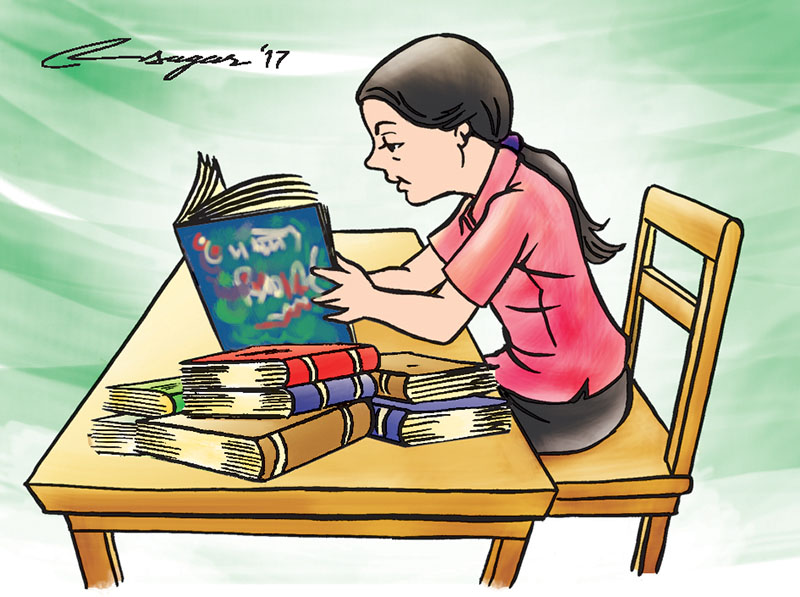Girls’ education: Failed programme
The School Sector Development Programme is considered a vessel to enable Nepal to achieve the Sustainable Development Goals that ensure inclusive and equitable quality education for all
The education sector, with the exception of the recent years, enjoys the lion’s share of funds from the State coffers. According to the Development Cooperation Report-2014/15, it is one of the top aid recipient sectors.
Friendly countries have continued to support Nepal’s education campaign for long. Nevertheless, it is not clear when Nepal exactly set off its educational campaign in partnership with others. However, literature shows that Dr. Hugh B. Wood from the US was invited to support the National Educational Commission in 1952.
It can be considered to be the first technical assistance that Nepal received in the field of education.
Due to the inevitable role of education in the development process, it truly deserves a significant share of the budget. There are some signs of success as well. The number of girls in SLC examination-2015 was higher than boys. It was a groundbreaking achievement in relation to girl’s education.
The other indicators include the high Net Enrollment Rate (NER) and literacy level. It sounds great, but it does not tell the truth about the girls from the marginalized communities.
While the arithmetic outcomes indicate commendable results, the other side of the coin is glum from the perspective of caste, ethnicity, geography and gender. The girls in schools are specially lagging far behind as their access to education has been found seriously disregarded.
It is corroborated by the data from the National Census-2011. According to it, Nepal’s literacy rate is 65.94% with 57.38% females and 75.13% males.
What is shocking is that the literacy rate of Dom, Mushar, Netuwa, Chamapr-Harijan and Sarki women is 14.16%, 16.66%, 23%, 27.74% and 53.66% respectively. Further, a report by the Department of Education in 2014 showed that only 23.10% of Terai Dalits are literate. It depicts that the girls from the marginalized communities are left far behind and it further widens gender disparity.
The census report also reveals that 18% of women aged 20-49 years married before the age 15 and 48.5% of them married before 18 years of age. While child marriage is outlawed in Nepal, it is socially accepted and pervasive. The research uncovers that married girls are 11 times more likely to be out of school compared to their unmarried peers. It is cited as the second most common cause of school drop-out for girls.
The data above challenges the two most fundamental targets set in 2000 in Dakar that stated: ‘Eliminate gender disparities in primary and secondary education by 2005, and achieve gender equality in education by 2015, with a focus on ensuring girls’ full and equal access to and achievement of basic education of good quality”.
The world, however, has stepped up to achieve 17 Sustainable Development Goals (SDGs).
The country with post disaster and conflict context requires need-based interventions in bridging the gap. Unfortunately, reports reveal that the education strategies failed to timely respond to the marginalized section of the society.
It is interesting to note that the National Review Report (2001– 2015) by the Ministry of Education admitted: “The big gap in literacy rates among different castes and ethnic groups indicates clearly that the existing programmes have failed to adequately reach the deprived groups”. The quality of education is in question too.
The National Early Grade Reading Programme shows that 36% of native Nepali speaking students in grade three could not read a single word in a text. It depicts reading skills of girls from non-Nepali speaking communities, as the majority of the girls from marginalized communities belong to non-Nepali speaking background.
“The failed programmes” and aid ineffectiveness in girls education, could have been the consequence of the poor accountability and weak financial management. Nepal Rastra Bank reveals Nepal’s trend of tardy capital budget spending.
It infuriated Premier Pushpa Kamal Dahal, and he reportedly directed ministers to expedite it. The international community is well aware of the fact as Renaud Meyer who heads UNDP in Nepal tweets, “6 months in the fiscal year, only 10% of capital budget spent. How will #Nepal Gov improve spending? @UNDP Nepal”.
Further, the issue of payables (beruju) for instance, has become chronic in Nepal. The Auditor General’s report 2070/71 ranks the Ministry of Education under the top ten ministries with a huge amount of beruju. The Corruption Index indicates that corruption has become epidemic.
The Paris Declaration contains 56 partnership commitments under the five principles, including mutual accountability, harmonization and aid alignment. It is time for all actors, including NGOs, to act and advocate making the State accountable as the School Sector Development Programme (SSDP) – the post SSRP initiatives, has been designed in line with the country’s vision of graduating from the LCD status.
It is also considered a vessel to enable Nepal to achieve the Sustainable Development Goals that ensure inclusive and equitable quality education for all. The government and donors as per the pledges and legal obligations need to swiftly act to ensure that all girls enjoy their rights to education.
Gurung is a journalist serving as an independent consultant (media, communication and research)






